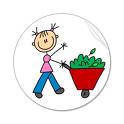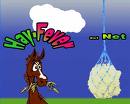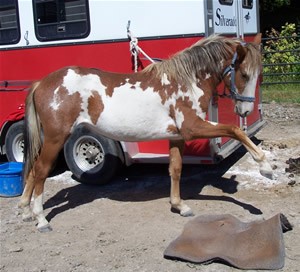
Might this frog be a prince after all?
(This blog receives more comments than any of the hundreds of others I have ever posted. If you would like to leave a comment on this topic, PLEASE DO SO AT THE FOLLOWING URL ADDRESS: http://www.herbsandanimals.com/?p=681 instead of at the bottom of this page. I have moved my blog to my main web site, so all comments should be posted there and will be responded to there. Thank you! Oh – you can go to that link now and read the same post at that location. Again, PLEASE DO NOT LEAVE A COMMENT ABOUT THIS ARTICLE ON THIS PAGE. Thank you!)
________________________________________________________________________________________
Some of the hardest cases I handle are the goodbyes — where an animal has come to the end of his life, or his life has been ended suddenly and unexpectedly, and he and his person must both deal with the grief of physical separation.
In almost all such cases the subject of reincarnation comes up. Not every time, but most of the time. Will we be together again? Does he plan to come back to me? When? How? How will I know him? Have we ever been together before? Many people are so devastated when they lose a beloved animal that they themselves don’t want to go on living. So often the only thread that helps them keep functioning is thinking they will see their animal again, in this lifetime.
To take a look at the multi-faceted possibility of a departed animal spirit being reunited with his or her person through reincarnation, first one must believe in reincarnation in the first place. And, of course, many people do not. Secondly, one must make the leap that animals too can reincarnate, which would then mean that yes, they do have souls – another point of heated argument.
For this blog post, and based on the hundreds of conversations I’ve had with animals about this possibility, ANIMALS DO HAVE SOULS AND THEY CAN AND DO REINCARNATE. If that is simply too much to entertain, then you might quit reading this entry now (and no disrespect to your beliefs is intended).
First, let’s look at animal reincarnation per se. The following is a snippet from a conversation with a horse which had contained enough odd comments earlier in the session – about adapting to his “horse body” — to lead me finally to ask this question: (I’m “L”; the horse is “M”.)
- L: Major, we are wondering if you were ever a horse before?
- M: Heavens no! I would never have considered it!
- L: What were you?
- M: A person. (He shows me he was an “ancient,” like a great master spiritualist.)
- L: So why did you come back as a horse?
- M: To find Suzanne [his person] and work with her on lessons of trust (for both of us).
- L: Really?! So have you two been together before?
- M: Oh yes, many times. In many ways.
And the session went on from there, with Major sharing much great wisdom and many insights on the subject of trust with Suzanne, via myself.
Regarding reincarnating and coming back into their person’s lives, many animals express a desire to do so. Some, on the other hand, don’t seem to be aware it’s a possibility (or perhaps they’re simply not interested).
Those who want to return may have some idea about when and how, or may have no idea at all. One Cocker Spaniel I talked to was determined to come back just as soon as possible — as another Cocker Spaniel, and he seemed to have a plan fairly well laid out. His person, Elizabeth, and I spoke with him a few times after he departed so that he could give her directions as to how to find him. He knew when he was coming back and told her to look in the newspaper for Cocker Spaniel litters at a certain point in time. He added details as to what he would look like: male, twice as large as any other pup in the litter, with very curly black and grey hair. He also gave her his new name – Brutus (a name my client NEVER would have chosen!). When she went to inspect the litter, there sat a puppy exactly like the one he had described, and, unbelievably, the family had dubbed him . . . you guessed it . . . Brutus!
This really happened. Exactly as he said it would! It is the only case I’ve ever had that played out in quite this way, and I was as amazed as Elizabeth at the outcome. It certainly was a story with a happy ending.
Every case is different, and most animals who come back tell their person not to look for them, that they, the animal, will find the person when the time is right. But you never can tell what will happen. So if you hope to see your beloved animal again, you very well might, and it seems the best approach to take about that possibility is simply to keep an open mind and heart and to be ready for just about anything.
(Please remember, if you’d like to comment on this post, please enter your comment here: http://www.herbsandanimals.com/?p=681. I appreciate all comments and try to answer every one. Thank you!)
*******************************************************************
IF YOU’D LIKE TO READ A CASE HISTORY ABOUT A SHAR PEI WHO HAS RETURNED TO HER PREVIOUS FOLKS, GO HERE.
 I admit that I am an over-enthusiastic gardener and weekend warrior. On the weekends I tend to go nuts with the hoe, tiller, and other garden tools. A few weeks ago I popped one end of my collarbones out of joint and I experienced a lot of pain every time I tried to use my arm.
I admit that I am an over-enthusiastic gardener and weekend warrior. On the weekends I tend to go nuts with the hoe, tiller, and other garden tools. A few weeks ago I popped one end of my collarbones out of joint and I experienced a lot of pain every time I tried to use my arm.











